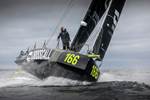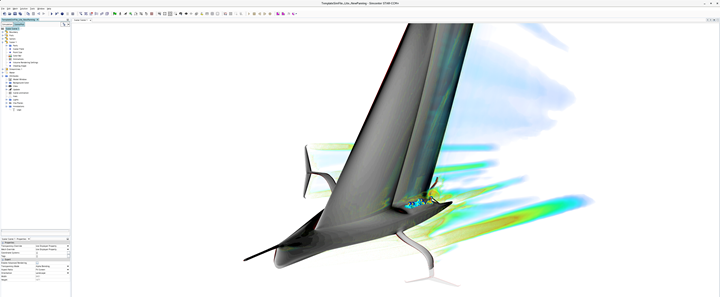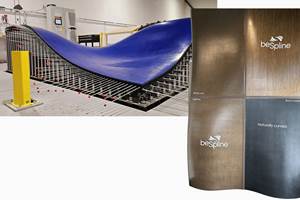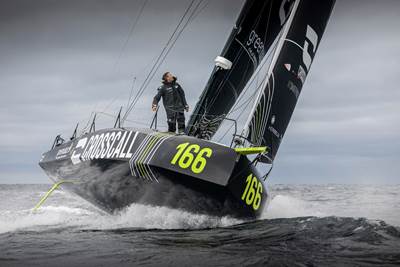Luna Rossa Prada Pirelli adopts Siemens Xcelerator portfolio for America’s Cup composite yacht
Critical digital tools and services increase design complexity, improve manufacturing repeatability and accelerate development for composite racing yacht construction, in and out of season.
Siemens Digital Industries Software (Waltham, Mass., U.S.) has announced that the Luna Rossa Prada Pirelli America’s Cup team is using the Siemens Xcelerator portfolio of software and services to design, simulate and optimize its racing yacht for the upcoming 37th America’s Cup challenge.
Manufactured with carbon fiber composites, the building process for the racing yacht prototype required nearly 10 months and more than 30,000 work hours of over 25 people and 40 members of the design team. For the construction of the hull and composite components, 5,000 square meters of carbon fiber were used in the different materials that make up the structural core. The prototype was conceived, designed and built at the Luna Rossa Prada Pirelli base in compliance with the rules imposed by the 37th America’s Cup Protocol.
According to Matteo Ledri, head of CFD, Luna Rossa Prada Pirelli team, the Siemens Xcelerator as a Service portfolio will provide critical tools that will “allow the team to design, analyze and evaluate all aspects of the boat’s hydraulics and fluid-dynamic performance. Using Siemens’ software, the hull, foils, rudder and sails can be analyzed as part of the digital twin, to understand how each surface responds to the changes in the project parameters, thus speeding up our work.”
The hull, foils, rudder and sails are designed and analyzed virtually using Simcenter STAR CCM+ software to understand how sails, hull and the complex hydrodynamics of the hydrofoil respond to the changes in the project parameters. Simcenter Amesim software is used to simulate all on-board hydraulic lines and optimize performance, an essential aspect given that on-board hydraulic power for the aerial parts of the boat is generated by four cyclors using pedal power.
Siemens Xcelerator is used to understand how sails, hull and the complex hydrodynamics of the hydrofoil respond to the changes in the project parameters.
Luna Rossa Prada Pirelli is also taking advantage of Xcelerator Share, the cloud-based collaboration capability in Siemens Xcelerator as a Service, to effectively manage increased design complexity, improve manufacturing repeatability across the growing number of parts undergoing thousands of engineering changes per year, in and out of racing season. In the highly competitive America’s Cup environment, these advanced shape description capabilities and high-fidelity CFD simulations of an extreme class of sailing boats enable team to meet their needs on the timetables demanded by global racing competitions.
Moreover, Siemens Xcelerator as a Service enables a high degree of automation, so the Luna Rossa Prada Pirelli team can fully leverage the power of modern high-performance computing (HPC) clusters, running thousands of simulations per day to quickly explore the characteristics of new designs in different environmental conditions. In addition, Siemens provides a dedicated support service to assist the team in extracting the maximum value out of their investment. The agreement also includes Siemens’ NX software, which Luna Rossa Prada Pirelli licensed to start evaluating its potential with a view to its future introduction.
“The Luna Rossa Prada Pirelli team’s selection of Siemens Xcelerator as a Service is another proof point that organizations at the bleeding edge of innovation are using our solutions to bring their ideas to life and find new areas for true innovation,” Franco Megali, vice president and CEO Italy, Israel and Greece, Siemens Digital Industries Software, adds. “Whether that’s teams competing in the world’s most extreme sailing races, taking new vehicles to the edge of space or building a more sustainable future for us all, pioneers are choosing our solutions.”
Related Content
Active core molding: A new way to make composite parts
Koridion expandable material is combined with induction-heated molds to make high-quality, complex-shaped parts in minutes with 40% less material and 90% less energy, unlocking new possibilities in design and production.
Read MoreComposite sidewall cover expands options for fire-safe rail components
R&D project by CG Rail explores use of carbon fiber-reinforced thermoplastics and recycled manufacturing scrap to meet fire safety, weight and volume targets.
Read MorePlant tour: BeSpline/Addcomp, Sherbrooke, QC, Canada
Composites automation specialist increases access to next-gen technologies, including novel AFP systems and unique 3D parts using adaptive molds.
Read MoreJeep all-composite roof receivers achieve steel performance at low mass
Ultrashort carbon fiber/PPA replaces steel on rooftop brackets to hold Jeep soft tops, hardtops.
Read MoreRead Next
Grand Largue Composites, Sicomin enable flax fiber-built Class40 racing yacht
Fibers, fabrics, epoxy resins and adhesives from Sicomin helped realize the lightweight, strong and stiff Crosscall yacht, capable of tackling extreme ocean racing conditions.
Read More“Structured air” TPS safeguards composite structures
Powered by an 85% air/15% pure polyimide aerogel, Blueshift’s novel material system protects structures during transient thermal events from -200°C to beyond 2400°C for rockets, battery boxes and more.
Read MoreVIDEO: High-volume processing for fiberglass components
Cannon Ergos, a company specializing in high-ton presses and equipment for composites fabrication and plastics processing, displayed automotive and industrial components at CAMX 2024.
Read More




























